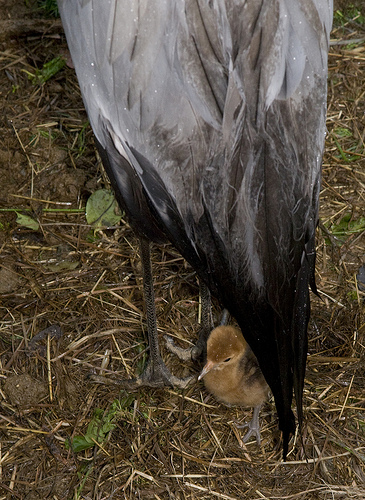
From the National Zoo:
On the heels of spring’s arrival, a wattled crane (Bugeranus carunculatus) chick hatched at the Smithsonian’s National Zoo March 20, the third of its kind in the park’s history. National Zoo veterinarians examined the chick and took a blood sample when it was 4 days old, which they will use to determine its sex. Visitors can see the chick and its parents at the Crane Run, part of the Bird House’s outdoor exhibits.
In stark contrast to their white-plumaged parents, wattled crane chicks sport yellow downy feathers and very small wattles—flaps of skin that prominently hang beneath the beak of adult birds. While scientists do not know exactly why these birds possess this trait, the size and shape of a wattle says a lot about a bird’s comfort or stress level. These cranes tend to extend their wattles when they are agitated or trying to assert dominance, and they will constrict their wattles when frightened or submissive.
Measuring 6 feet tall, the wattled crane is the largest of the six crane species that call Africa home; they are also the rarest. Although wattled cranes can be found in the wetlands of 11 countries in the sub-Saharan region, their numbers in many countries are few and continue to dwindle. Zambia contains the largest populations, with roughly 5,500 individuals. Wattled cranes are listed as vulnerable on the International Union for Conservation of Nature’s Red List of Threatened Species due to hunting, agricultural advancement, pest control and collisions with power lines.
We welcome your comments if you are 13 or older, and hope that our conversations here will be polite. You are responsible for the content of your comments.
We do not discriminate against any views, but may delete any of the following:
- violent, obscene, profane, hateful, or racist comments
- comments that threaten or harm the reputation of any person or organization
- advertisements or solicitations of any kind
- comments that suggest or encourage illegal activity
- multiple off-topic posts or repetitive posts that are copied and pasted
- personal information including, but not limited to, e-mail addresses, telephone numbers, mailing addresses, or identification numbers
In short: be nice and add to the discussion. If you continually violate this policy, we may limit your ability to comment in the future. If you have any questions or comments about this policy, please e-mail us.
